Using Scoped Variables in Devtron
Introduction
In Devtron, many configuration values such as a database name, memory limit, or service endpoint may need to be used in multiple places. Instead of entering the same value repeatedly, you can store it in a scoped variable.
A scoped variable (key-value pair) allows you to define a value once and reuse it. The value of the variable will depend on the scopes mentioned below:
For example, you can create a variable named db_host to store the database host URL and set its value to https://dev.company.com/mydb for development environment, and for production environment you can set its value to https://prod.company.com/mydb, at the time of deployment, Devtron will automatically choose the correct value based on the environment.
The table below illustrates how Devtron uses scoped variables defined for different scopes
| Scope | Variable | Values |
|---|---|---|
| Global | DB_NAME | central-db |
| Cluster | DB_NAME | AWS EKS (Cluster): eks-db GKE (Cluster): gke-db |
| Environment | DB_NAME | Dev (Environment): dev-db Prod (Environment): prod-db |
| Application | DB_NAME | App1 (Application): app1-db App2 (Application): app2-db |
| Env + App | DB_NAME | Dev + App1: dev-app1-db Prod + App2: prod-app2-db |
Precedence of Scoped Variables
If the same variable is defined at more than one scope, Devtron resolves the value based on the following precedence order:
| Precedence Order | Scope |
|---|---|
| 1 (Highest) | Environment + Application  |
| 2 | Application  |
| 3 | Environment  |
| 4 | Cluster  |
| 5 (Lowest) | Global |
- Environment + App: This is the most specific scope, and it will take precedence over all other scopes. For example, the value of
DB_Namevariable for theapp1application in thedevenvironment would bedev-app1-db, even though there is a globalDB_Namevariable set tocentral-db. If a variable value for this scope is not defined, the App scope will be checked. - Application: This is the next most specific scope, and it will take precedence over the
Environment,Cluster, andGlobalscopes. For example, the value ofDB_Namevariable for theapp1application would beapp1-db, even though the value ofDB_Nameexists in lower scopes. If a variable value for this scope is not defined, the Environment scope will be checked. - Environment: This is the next most specific scope, and it will take precedence over the
ClusterandGlobalscopes. For example, the value ofDB_Namevariable in theprodenvironment would beprod-db, even though the value ofDB_Nameexists in lower scopes. If a variable value for this scope is not defined, the Cluster scope will be checked. - Cluster: This is the next most specific scope, and it will take precedence over the
Globalscope. For example, the value ofDB_Namevariable in theGKEcluster would begke-db, even though there is a globalDB_Namevariable set tocentral-db. If a variable value for this scope is not defined, the Global scope will be checked. - Global: This is the least specific scope, and it will only be used if no variable values are found in other higher scopes. The value of
DB_Namevariable would becentral-db.
Advantages of using scoped variables
-
Reduces repeatability: Configuration management team can centrally maintain the static data.
-
Simplifies bulk edits: All the places that use a scoped variable, get updated when you change the value of the variable without requiring manual edits. If the scoped variable is being used in Deployment Template, ConfigMap, Secret, or Job the actual value will be resolved and propagated upon next trigger.
-
Keeps data secure: You can mark a variable as sensitive, so its value is hidden in the UI, reducing the risk of misuse or leakage. Refer How to Define a Scoped Variable to learn more.
How to Define a Scoped Variable
Only super admins can define scoped variables.
In Devtron, you can define scoped variables by using a YAML template. It will contain a schema for defining the scoped variables.
Depending on your use case, you can do either one of the following:
| Action | Description |
|---|---|
| Download the YAML Template and define variables from scratch | In case you are defining the Scoped Variables for the first time:
|
| Edit the existing saved YAML configuration | If you wish to add, update or delete the existing scoped variables, you can edit the existing saved YAML configuration using any of the following methods:
|
Download the Template
-
From the left sidebar, go to Global Configurations → Scoped Variables
-
Click Download template.
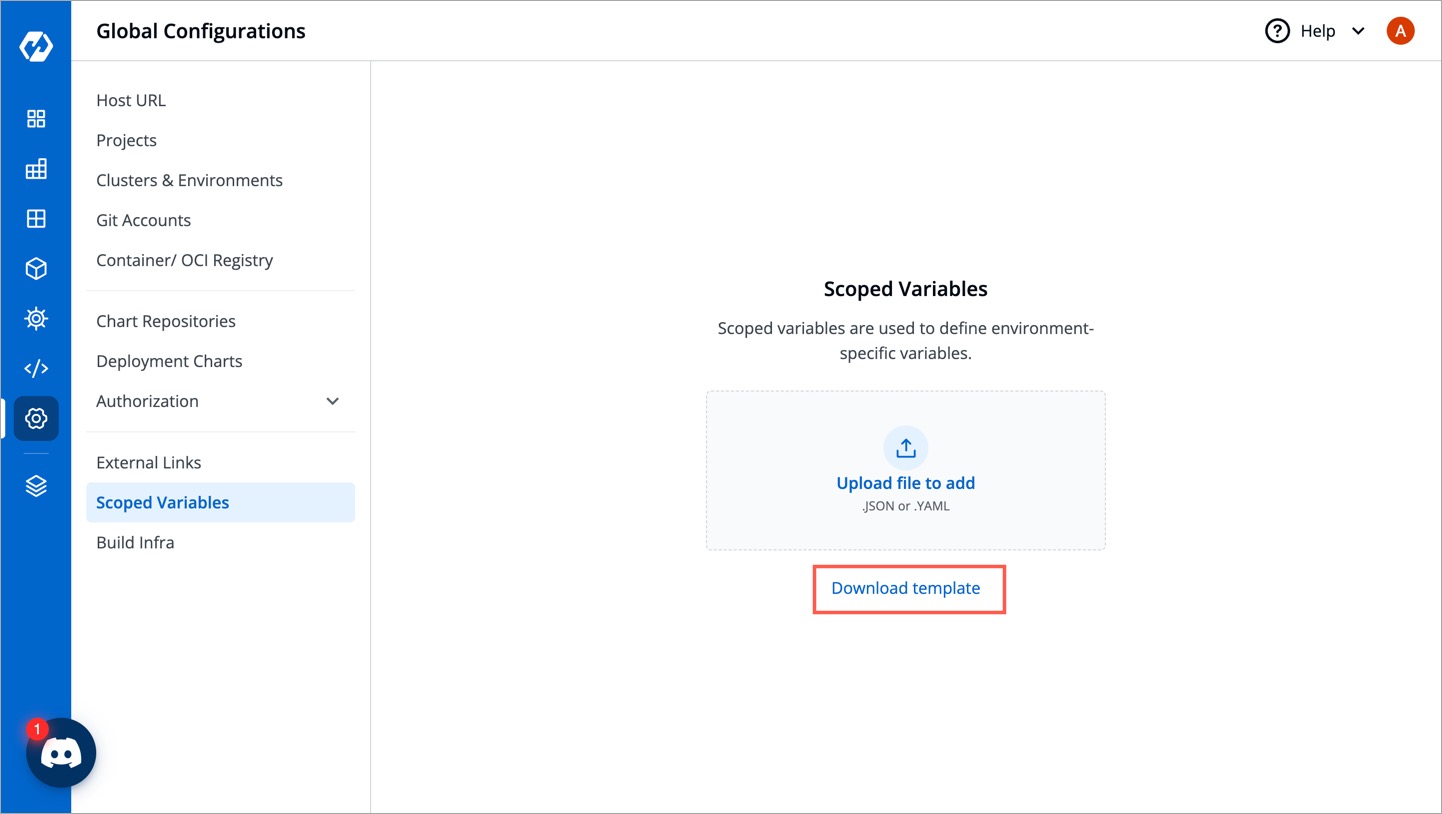
-
Open the downloaded template using any code editor (say VS Code).
Enter the Values
The YAML file contains key-value pairs that follow the below schema:
| Field | Type | Description |
|---|---|---|
apiVersion | string | The API version of the resource (comes pre-filled) |
kind | string | The kind of resource (i.e. Variable, comes pre-filled) |
spec | object | The complete specification object containing all the variables |
spec.name | string | Unique name of the variable, e.g. DB_URL |
spec.shortDescription | string | A short description of the variable (up to 120 characters) |
spec.notes | string | Additional details about the variable (will not be shown on UI) |
spec.isSensitive | boolean | Whether the variable value is confidential (will not be shown on UI if true) |
spec.values | array | The complete values object containing all the variable values as per context |
The spec.values array further contains the following elements:
| Field | Type | Description |
|---|---|---|
category | string | The context, e.g., Global, Cluster, Application, Env, ApplicationEnv |
value | string | The value of the variable |
selectors | object | A set of selectors that restrict the scope of the variable |
selectors.attributeSelectors | object | A map of attribute selectors to values |
selectors.attributeSelectors.<selector_key> | string | The key of the attribute selector, e.g., ApplicationName, EnvName, ClusterName |
selectors.attributeSelectors.<selector_value> | string | The value of the attribute selector |
Here's a truncated template containing the specification of two variables for your understanding:
apiVersion: devtron.ai/v1beta1
kind: Variable
spec:
# First example of a variable
- name: DB_URL
shortDescription: My application's customers are stored
notes: The DB is a MySQL DB running version 7.0. The DB contains confidential
information.
isSensitive: true
values:
- category: Global
value: mysql.example.com
# Second example of a variable
- name: DB_Name
shortDescription: My database name to recognize the DB
notes: NA
isSensitive: false
values:
- category: Global
value: Devtron
- category: ApplicationEnv
value: app1-p
selectors:
attributeSelectors:
ApplicationName: MyFirstApplication
EnvName: prod
Upload the Template
-
Once you save the YAML file, go back to the screen where you downloaded the template.
-
Click Upload file to add, to upload your saved YAML file.

-
The content of the file will be uploaded for you to review and edit. Click Review Changes.
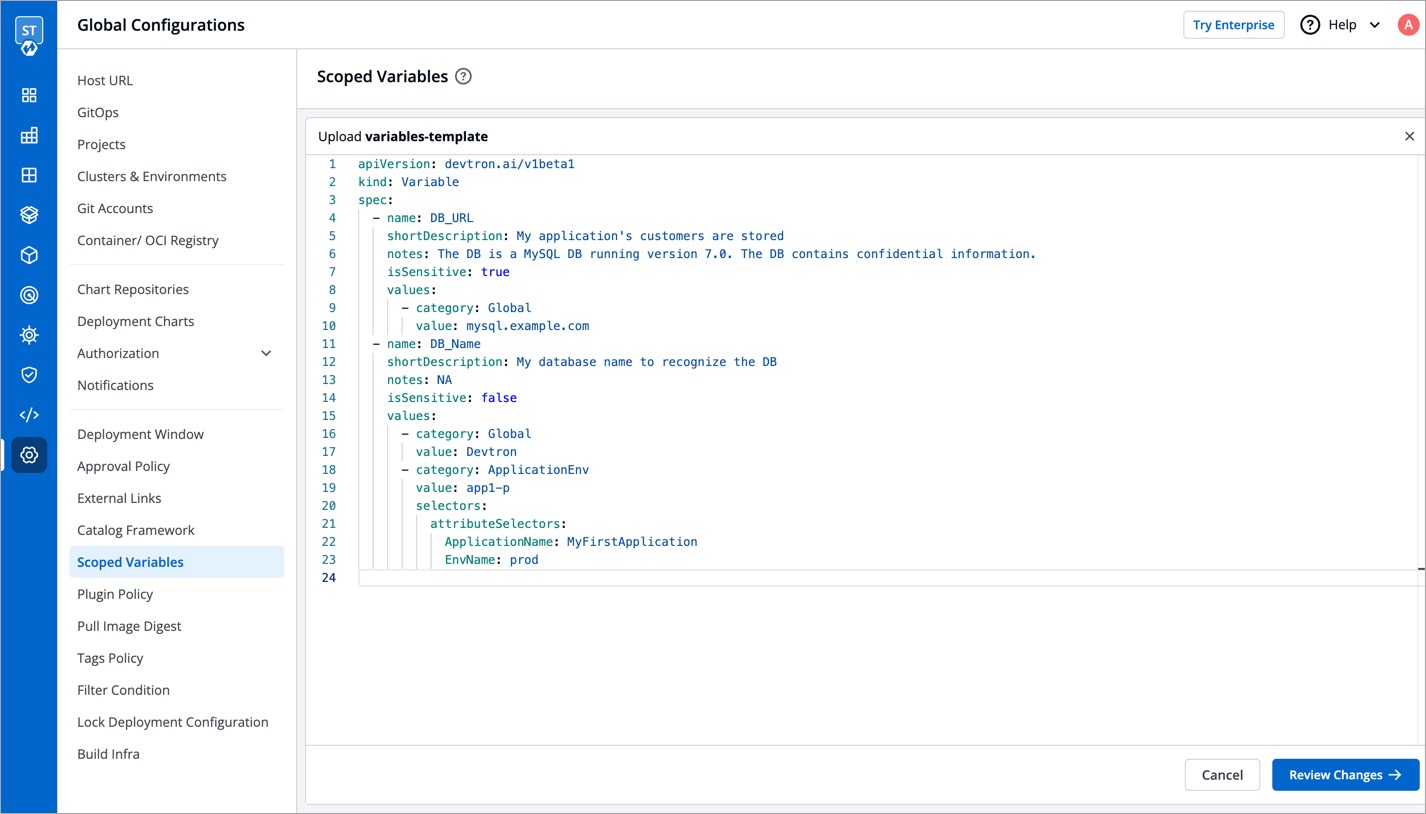
-
You may check the changes between the last saved file and the current one before clicking Save.
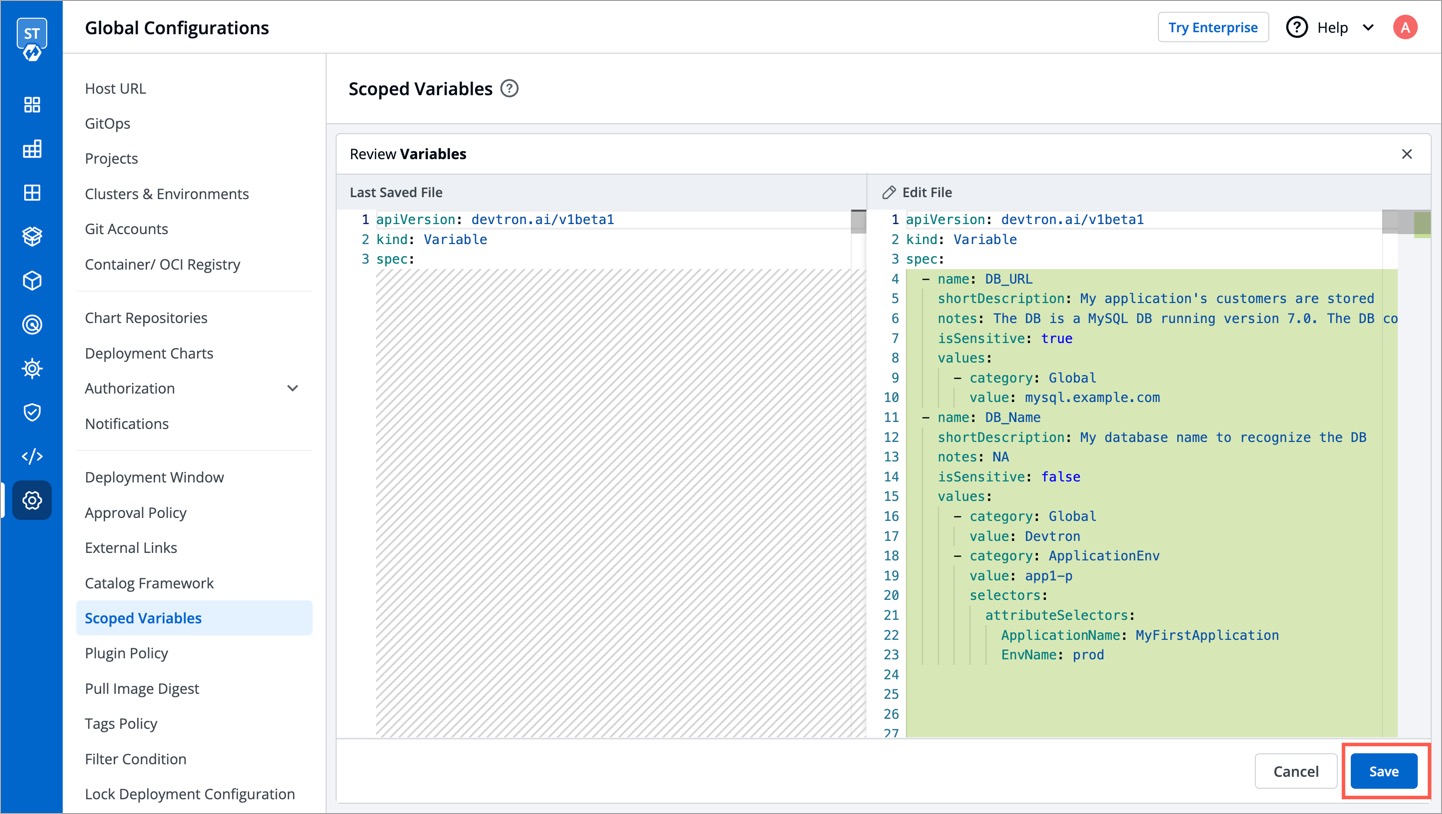
-
Click the Variable List tab to view the variables. Check the How to Use a Scoped Variable section to know more.
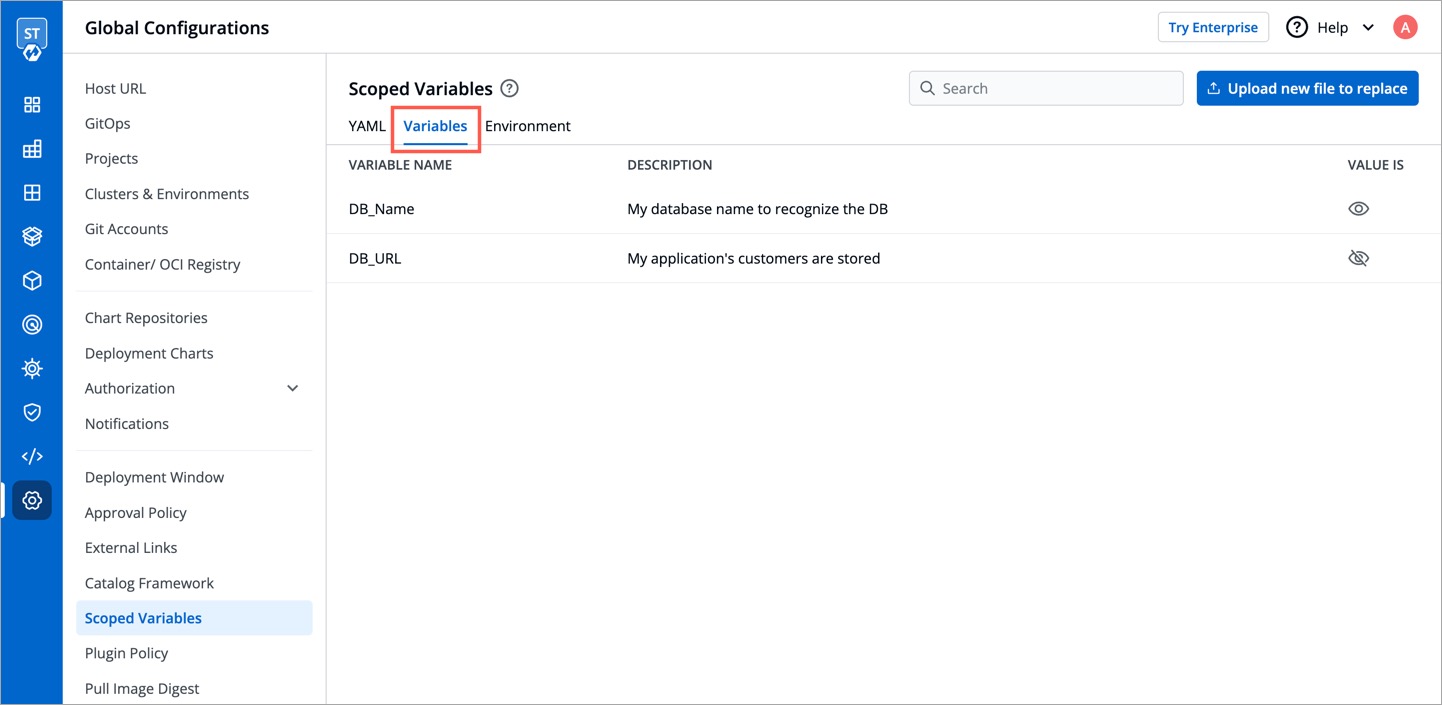
Defining YAML values in scoped variables 
In Devtron, Scoped variables usually store simple values like strings or numbers, for example, if you want to connect multiple applications to the same SonarQube server, you can define a variable for its endpoint URL once instead of entering it everywhere.
SONAR_ENDPOINT: https://sonarqube.yourcompany.com
But, in some cases, you may need to define more detailed configuration in a scoped variable, such as autoscaling configuration or resource configuration. You can achieve this by defining a YAML snippet as the value of a scoped variable.
Defining YAML snippets as the value of a scoped variable will help you to reuse YAML configuration across multiple applications or environments. Scoped variables with YAML snippets can be changed based on the context (category) such as Global, Cluster, Environment, Application, Environment+Application.
Here's a truncated template containing the specification of one scoped variable with a YAML snippet as its value defined for different contexts for your understanding:
apiVersion: devtron.ai/v1beta1
kind: Variable
spec:
- notes: Resource Configuration
shortDescription: Scoped variable with YAML snippet
isSensitive: false
name: resources # Defining name for the variable.
values:
- category: Application
value: # Insert the YAML configuration block with proper indentation
limits:
cpu: 100m
memory: 100Mi
requests:
cpu: 100m
memory: 100Mi
selectors:
attributeSelectors:
ApplicationName: banking-preprod
- category: Env # Defining the variable for an environment.
value:
limits:
cpu: 75m
memory: 75Mi
requests:
cpu: 50m
memory: 50Mi
selectors:
attributeSelectors:
EnvName: devtron-demo # Specifying the environment
- category: Env # Defining variable's values for another environment
value:
limits:
cpu: 200m
memory: 200Mi
requests:
cpu: 100m
memory: 100Mi
selectors:
attributeSelectors:
EnvName: banking # Specifying another environment name.
- category: Global # Defining Variable's Values for global context.
value:
limits:
cpu: 50m
memory: 50Mi
requests:
cpu: 50m
memory: 50Mi
How to Edit an Existing Scoped Variable
Only super admins can edit scoped variables
Only a super-admin can edit existing scoped variables.
Option 1: Directly edit using the UI
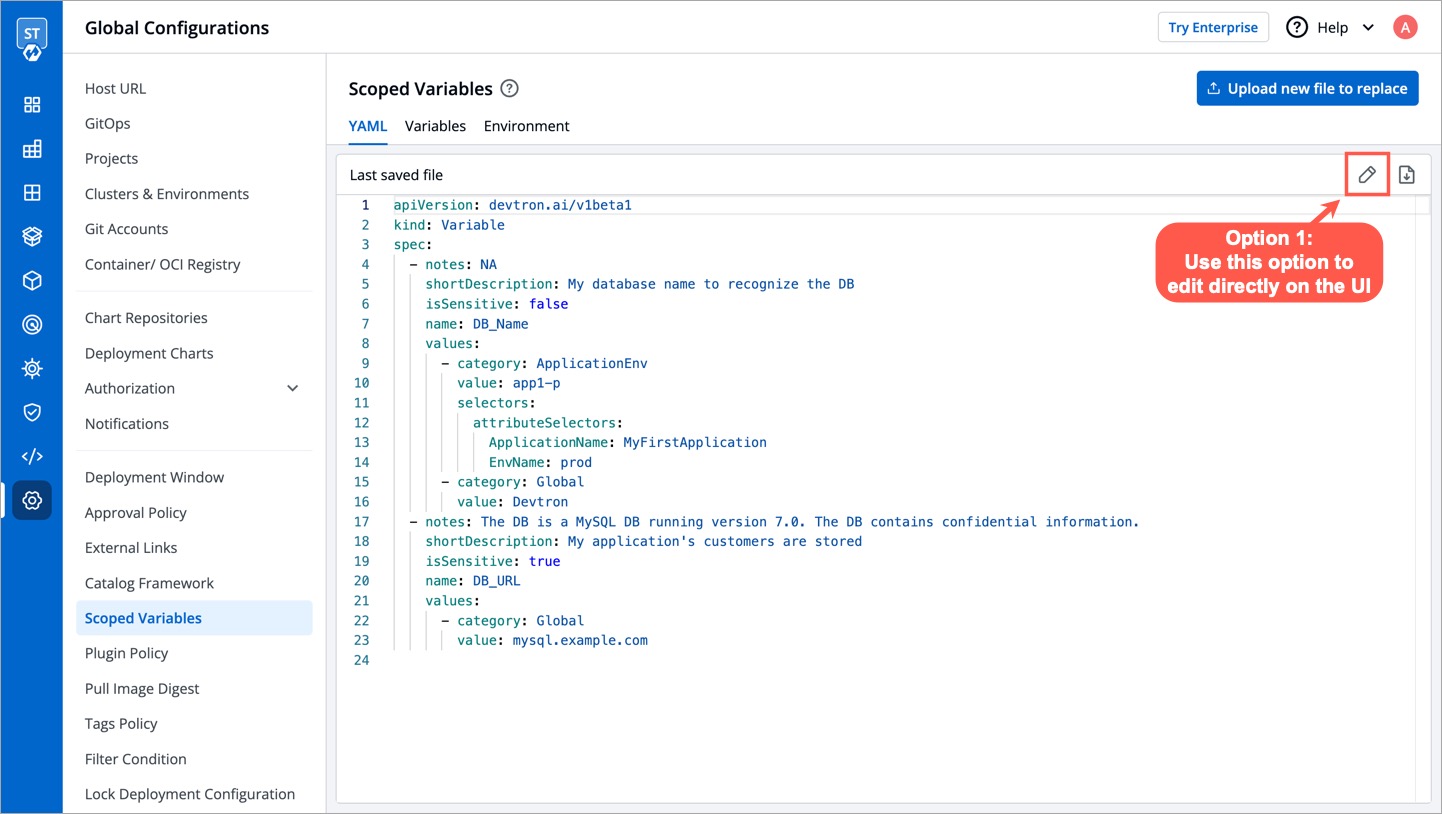
Option 2: Reupload the updated YAML file

Re-uploading the YAML file will replace the previous file, so any variable that existed in the previous file but not in the latest one will be lost
Option 3: Edit through 'Environments' tab
The Environments tab allows you to view and edit scoped variable values for individual environments.
- Go to the Environments tab; you will see a list of all environments and how many scoped variables are defined for each of them.
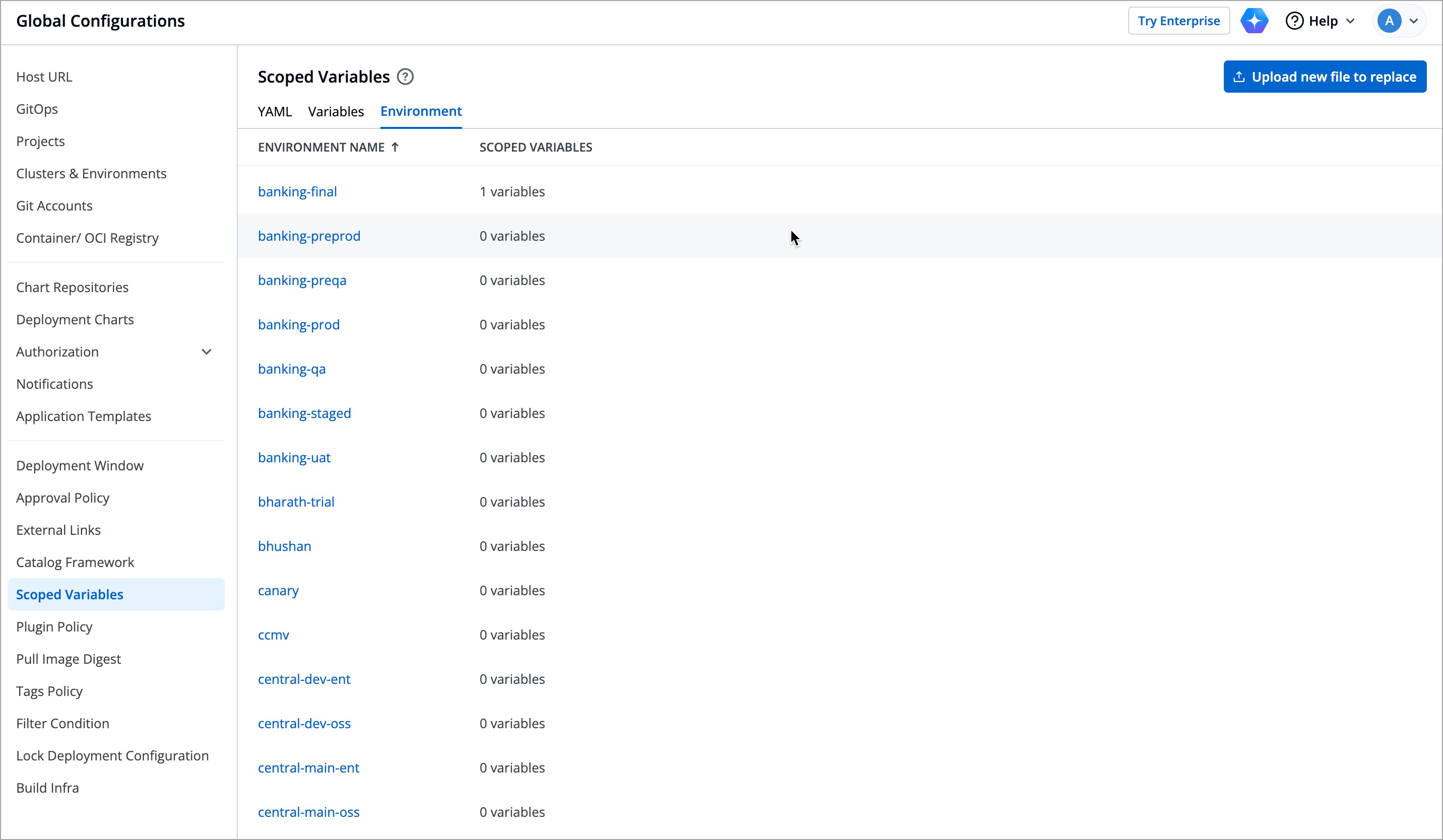
-
Click the preferred environment name to view or edit.
-
You can edit the variables using the GUI or YAML mode.
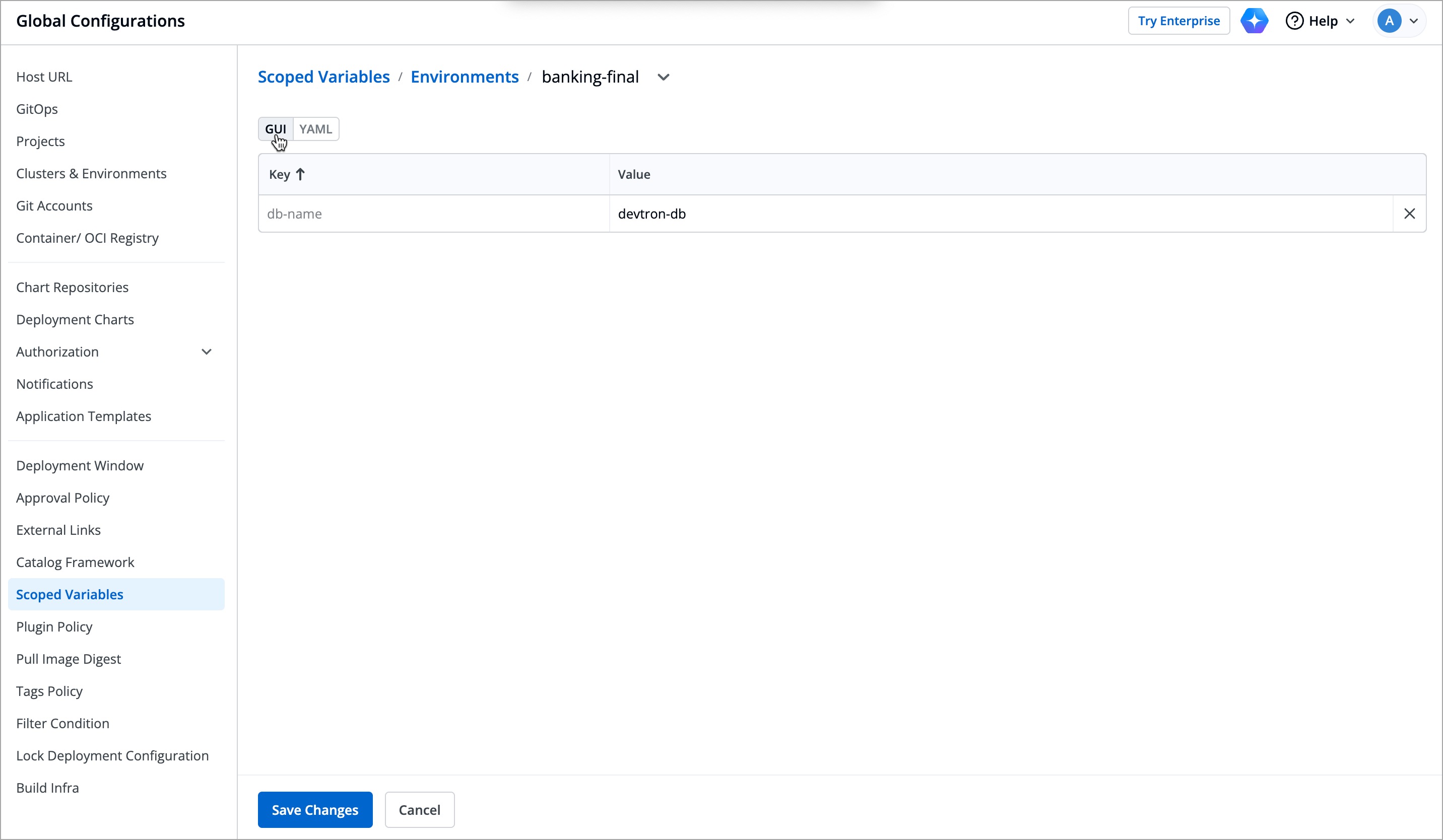
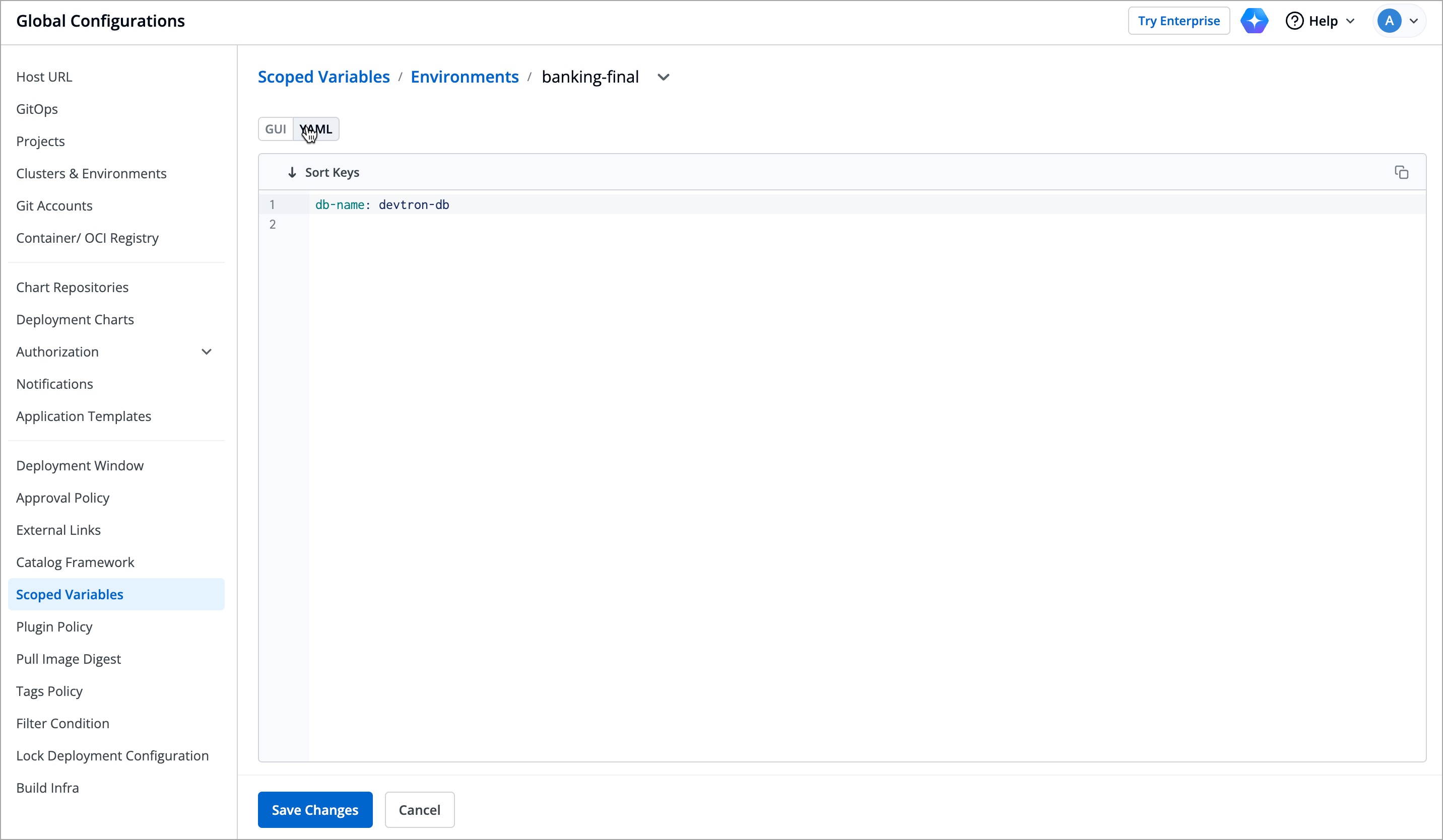
Any changes you made through this method will also update the saved YAML configuration.
How to Use a Scoped Variable
Users need to have Admin permission or above (along with access to the environment and application) to enable to use a scoped variable.
Once a variable is defined, it can be used by your authorized users on Devtron. A scoped variable widget would appear only on the screens that support its usage.
Currently, the widget is shown only on the following screens in App Configuration:
-
Workflow Editor → Edit build pipeline → Pre-build stage (tab)
-
Workflow Editor → Edit build pipeline → Post-build stage (tab)
-
Workflow Editor → Edit deployment pipeline → Post-Deployment stage (tab)
-
Workflow Editor → Edit deployment pipeline → Post-Deployment stage (tab)
-
Deployment Template
-
ConfigMaps
-
Secrets
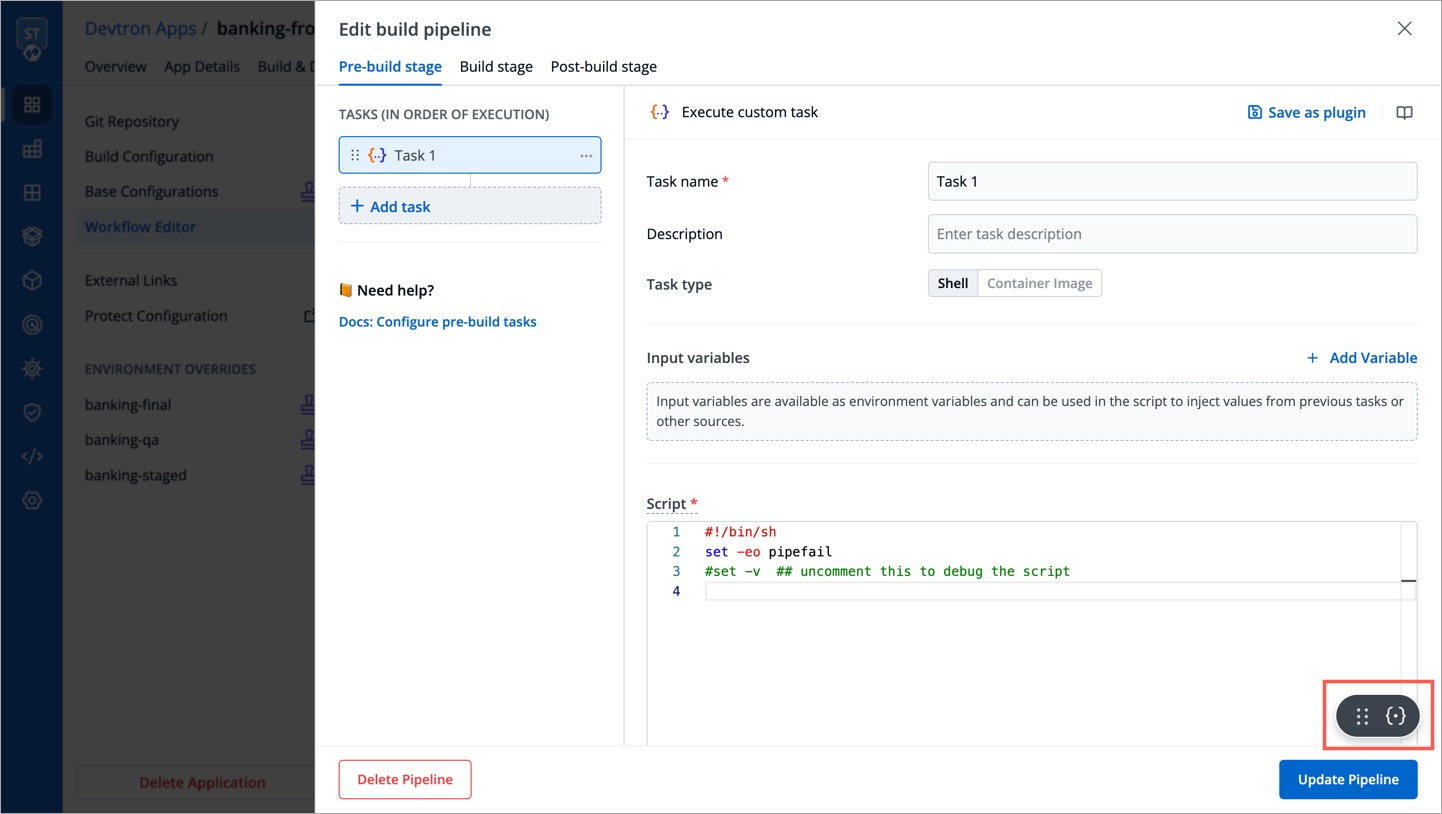
To use a scoped variable, click on the floating widget; a list of variables will be visible.

Use the copy button to copy a relevant variable of your choice.
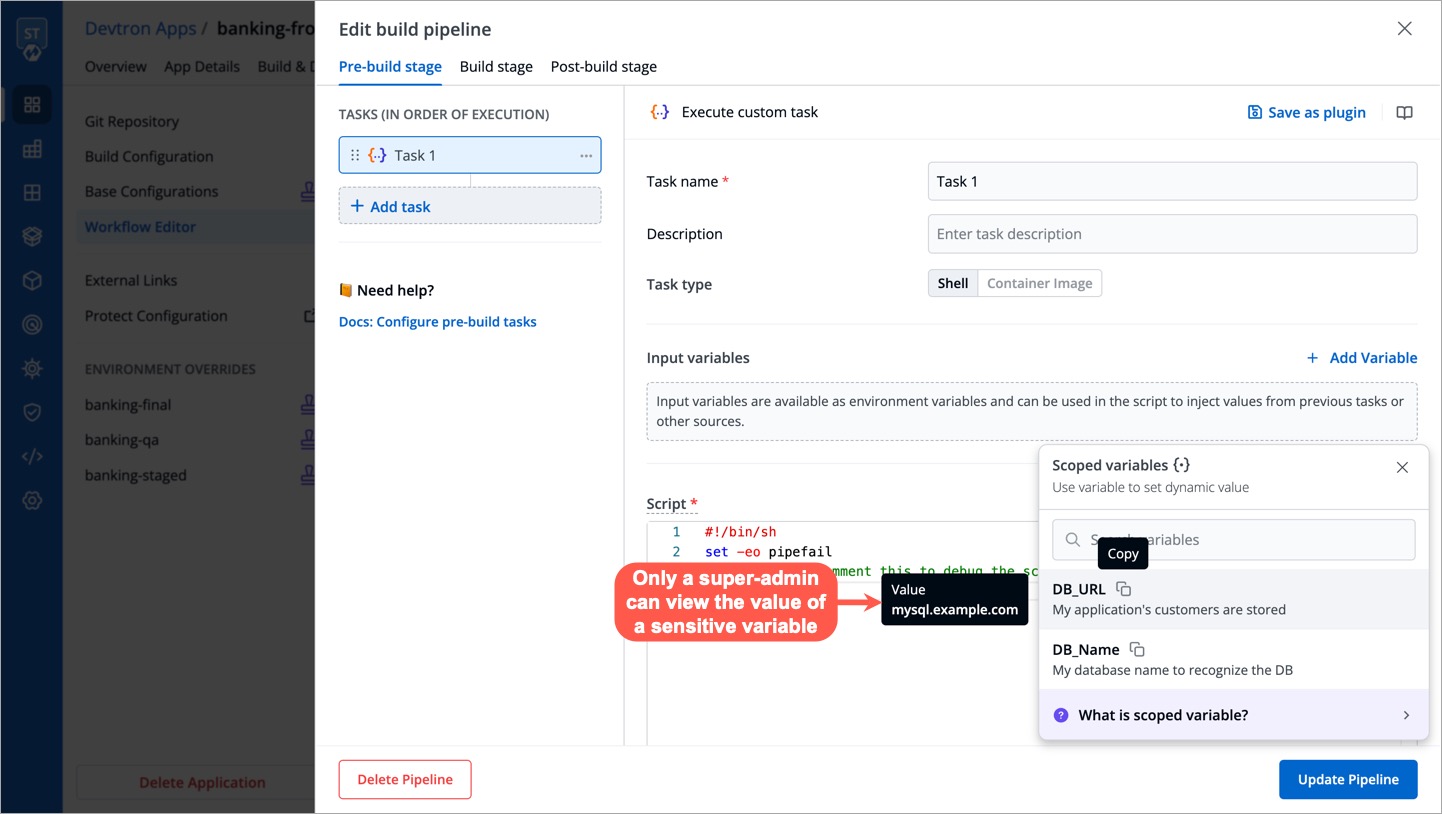
It would appear in the following format upon pasting it within an input field: @{{variable-name}}.
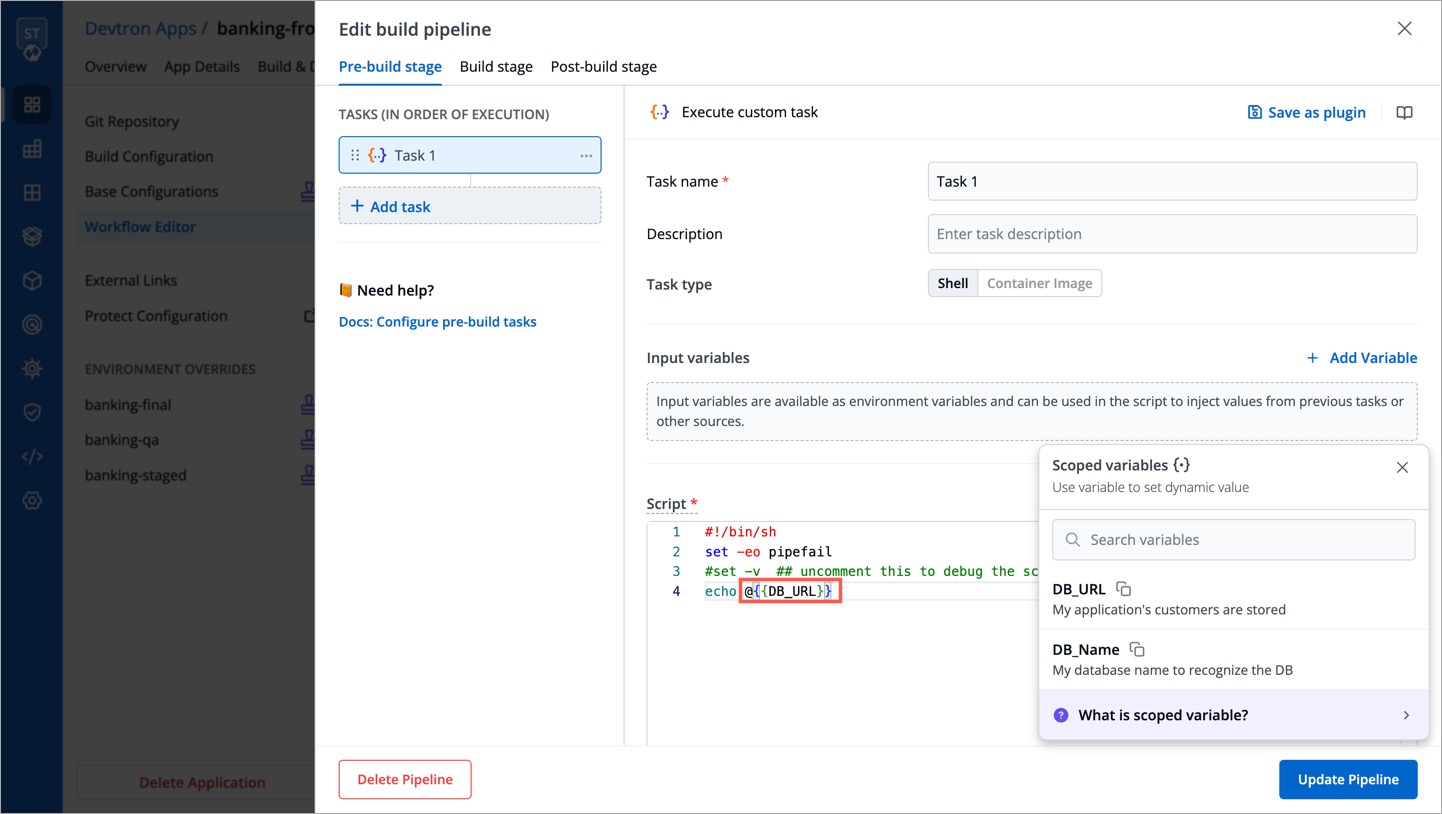
In case you are using a scoped variable in deployment template, you need to encapsulate it in double quotes i.e., "@{{variable-name}}"
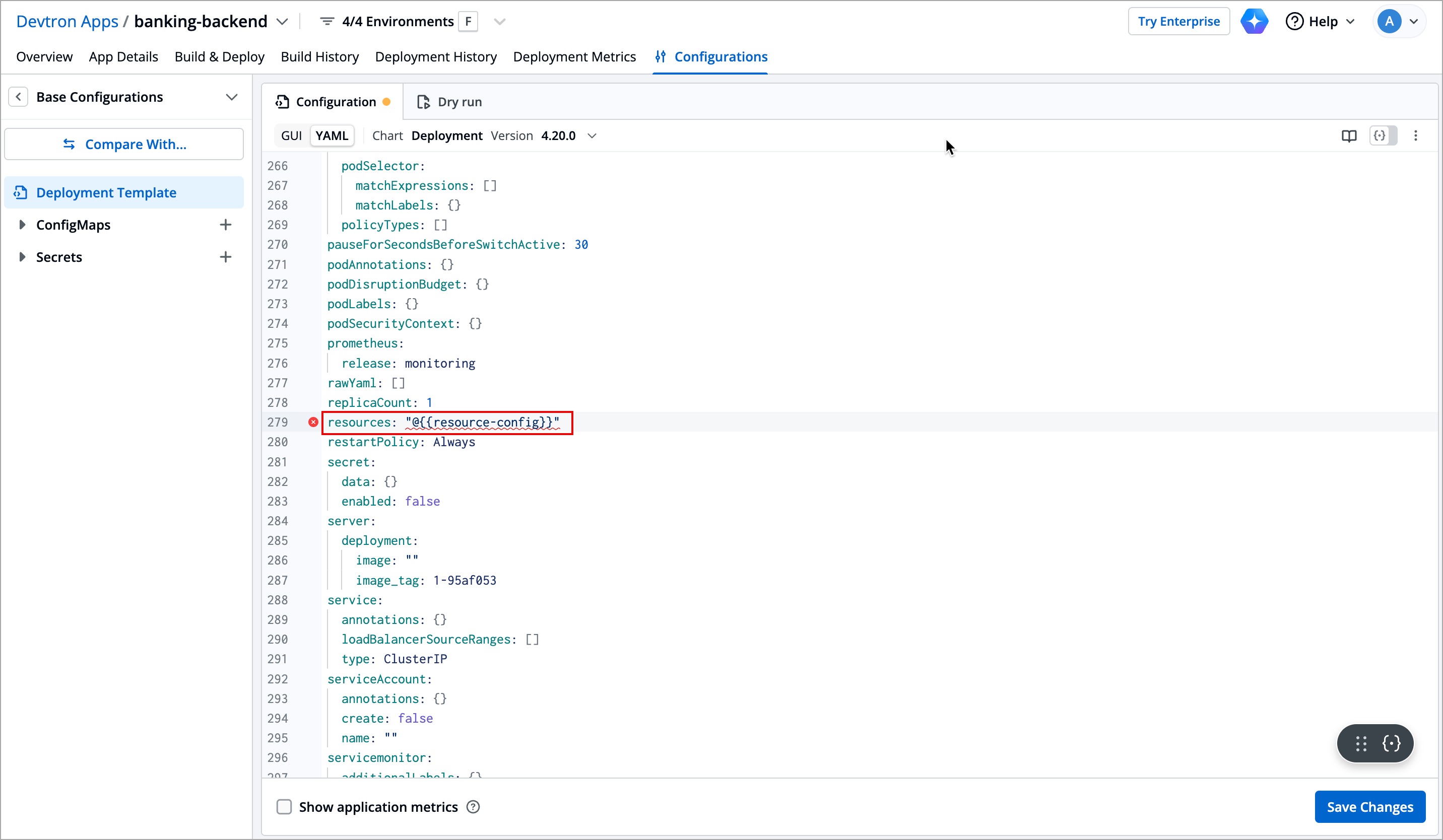
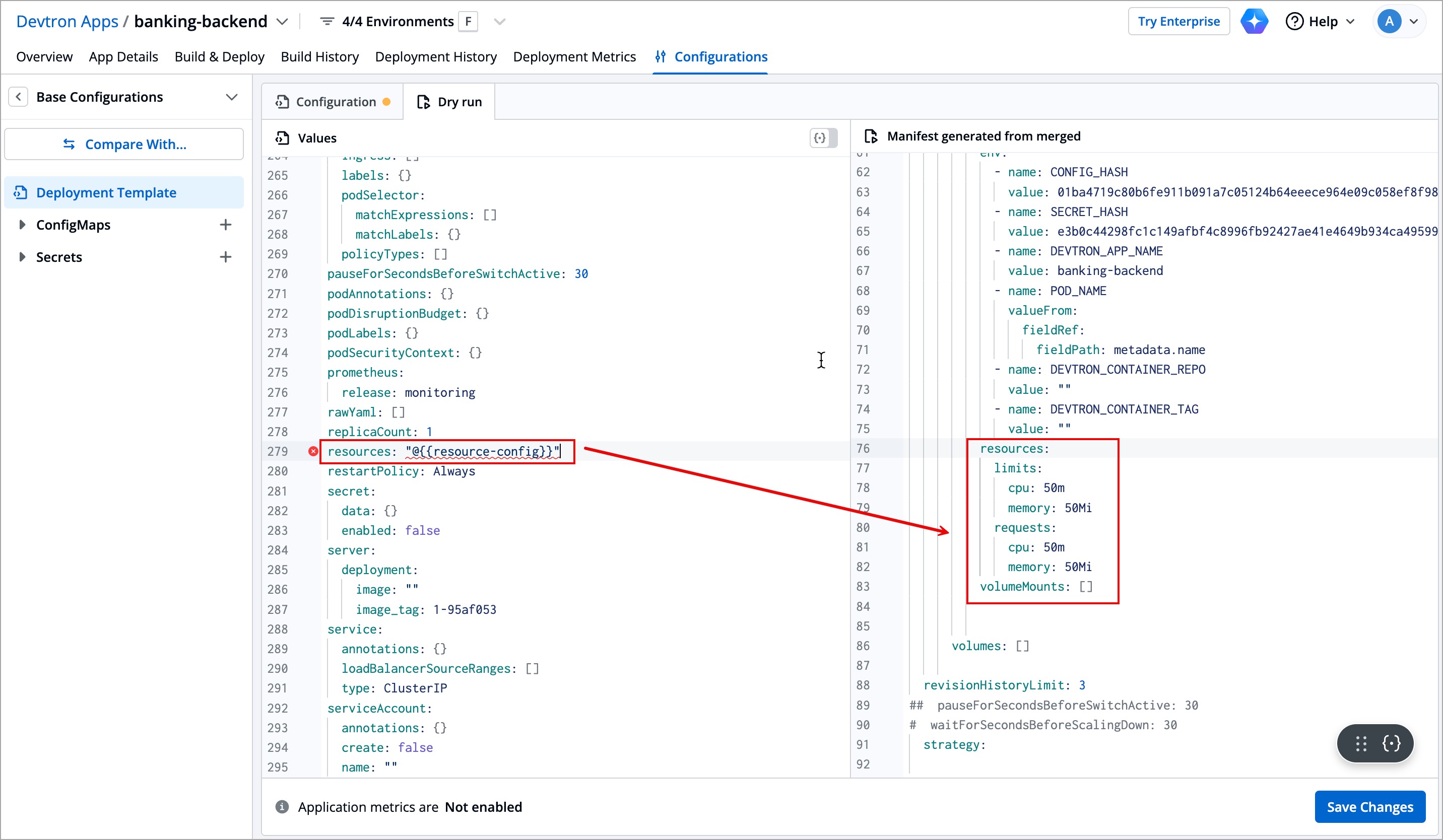
Note: Ignore the red underline while using a scoped variable in the deployment template.
List of Predefined Variables
There are some system variables that exist by default in Devtron that you can readily use if needed:
- DEVTRON_NAMESPACE: Provides name of the namespace
- DEVTRON_CLUSTER_NAME: Provides name of the cluster configured on Devtron
- DEVTRON_ENV_NAME: Provides name of the environment
- DEVTRON_IMAGE_TAG: Provides image tag associated with the container image
- DEVTRON_IMAGE: Provides full image path of the container image, e.g.,
gcr.io/k8s-minikube/kicbase:v0.0.39 - DEVTRON_APP_NAME: Provides name of the application on Devtron
Currently, these variables do not appear in the scoped variable widget, but you may use them.